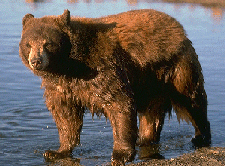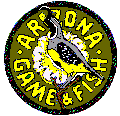|
 One
of the larger Arizona mammals, the black bear can also have a
blond, reddish ("cinnamon"), or brown coat. An omnivore with an
acute sense of smell, black bears may find their way into your
campsite should any food or garbage be left out. One
of the larger Arizona mammals, the black bear can also have a
blond, reddish ("cinnamon"), or brown coat. An omnivore with an
acute sense of smell, black bears may find their way into your
campsite should any food or garbage be left out.
Description: Large and lumbering, black bears can be up
to three feet at the shoulder and weigh up to 400 pounds.
Habitat: Black bears are found in chaparral, pine, and
aspen-fir forested areas throughout the state at elevations ranging
from 4,000 to 10,000 feet.
Food Preferences: Being omnivores, black bears feed on
both plants and animals. The bulk of their diet, though, are
berries, roots, grass, cactus fruits, insects, and occasionally
small mammals or carcasses.
Breeding notes: Black bears breed in July. Remarkably,
the young (usually two per female) are born to a hibernating mother
in its den during January. Newborn bears weigh just a little over
an ounce. The young feed on milk from their unsuspecting mother
until she wakes a few months later and emerges from her den. Cubs
stay with their mother for about 1.5 years and generally disperse
their second fall.
Predators or Enemies:
Practically none
Size Individual Range: 7-50
square miles
Distribution: 4,000-10,000 feet, in forest areas
throughout Arizona
Live Weight: Male: 350 lbs. /
Female 250 lbs.
Hunting hints: Hunters can benefit from scouting for
berry patches or oak stands. It's best to scout prior to your hunt
in the early morning or late evening hours. Look for sign (tracks
and scat) of bears along trails and in feeding areas. An
Apache-Sitgreaves National Forests map is essential.
Hunting Hot Spots:
- Hannagan Meadow Area: Hannagan Meadow offers high elevation
mixed conifer habitat interspersed with small openings and
riparian meadows. Look for bears foraging on berries along
streams or on acorns in Gambel oak stands. The Hannagan Meadows
area is accessed by FR24 and FR25.
- East Eagle Creek: Characterized by deep canyons, heavy
vegetation, numerous side creeks, and few open areas. However,
several trails allow for good access. Look for sign along the
pine tree "strings" on the canyon bottoms and also on trails.
Access is via Highway 191. Stray Horse Campground is a few miles
north.
- Sheep Wash/Cottonwood Canyon: Vegetation is mostly pinyon
pine-juniper grasslands. While there are not many trails, the
openness of the area lends itself to relatively easy
cross-country walking. Find a good high point and use binoculars
to glass the landscape. Often, bears from the nearby San Carlos
Indian Reservation travel through the area. Access is via FR217
or Highway 191.
 Published with the permission of: Arizona Game &
Fish Department Region 1, Pinetop. HC 66, Box 57201, Pinetop, AZ
85935, (928) 367-4281. If you would like to visit the home page for
the Arizona Game & Fish Department, you may find the Department at
www.gf.state.az.us. Published with the permission of: Arizona Game &
Fish Department Region 1, Pinetop. HC 66, Box 57201, Pinetop, AZ
85935, (928) 367-4281. If you would like to visit the home page for
the Arizona Game & Fish Department, you may find the Department at
www.gf.state.az.us.
|

 Published with the permission of: Arizona Game &
Fish Department Region 1, Pinetop. HC 66, Box 57201, Pinetop, AZ
85935, (928) 367-4281. If you would like to visit the home page for
the Arizona Game & Fish Department, you may find the Department at
Published with the permission of: Arizona Game &
Fish Department Region 1, Pinetop. HC 66, Box 57201, Pinetop, AZ
85935, (928) 367-4281. If you would like to visit the home page for
the Arizona Game & Fish Department, you may find the Department at